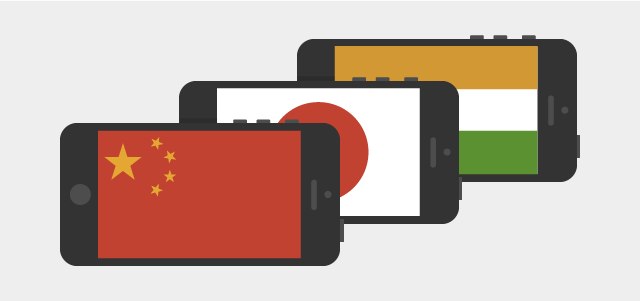How Social Media Behaviors Differ Across Asia Pacific
Explore the diverse landscape of social media behaviors across the Asia Pacific region. From the latest trends in digital engagement to unique cultural practices influencing online interactions, this article delves into how social media usage varies across countries like Japan, China, India, and Australia. Understand the impact of local traditions, technological advancements, and demographic shifts on social media habits and strategies.

The Asia Pacific region is a vibrant and diverse area encompassing a variety of cultures, languages, and traditions. This diversity is reflected in how individuals and communities engage with social media platforms. Understanding these differences in social media behaviors is crucial for businesses, marketers, and social media strategists aiming to connect with audiences effectively. This comprehensive exploration delves into the unique social media behaviors across various countries in the Asia Pacific, highlighting the factors that influence these differences and offering insights for effective engagement.
Cultural Influences on Social Media Engagement
Cultural norms and values significantly shape social media behaviors in the Asia Pacific region. Countries such as Japan, South Korea, India, and Australia exhibit distinct social media trends that are often influenced by their cultural backgrounds.
In Japan, for example, social media use tends to be more restrained and formal compared to other countries. Users often prefer anonymity, which leads to the popularity of platforms that allow for private interactions. Conversely, in Australia and India, social media usage is more open and expressive, reflecting the culture of community and direct communication.
Understanding these cultural influences can help businesses tailor their messaging and engagement strategies to resonate with specific audiences. By aligning social media content with local customs and preferences, brands can build trust and foster deeper connections with users.
Platform Preferences Across the Region
Social media platform preferences vary widely throughout the Asia Pacific region. While Facebook remains a dominant force globally, other platforms have emerged as favorites in specific countries due to local needs and user behaviors.
In China, for instance, Facebook is blocked, leading to the rise of domestic platforms such as WeChat and Weibo. WeChat serves as an all-in-one app for messaging, social networking, and mobile payments, making it integral to daily life for many Chinese users. Similarly, in Southeast Asia, platforms like TikTok and Instagram have gained immense popularity, particularly among younger audiences.
These platform preferences reflect not only cultural differences but also the technological landscape and regulatory environments within each country. Businesses must be aware of these preferences to effectively engage their target audiences on the right platforms.
Age Demographics and Social Media Usage
Age demographics play a significant role in shaping social media behaviors across the Asia Pacific region. Different age groups exhibit varying preferences for platforms, content types, and engagement styles.
Younger users, particularly those in the millennial and Gen Z demographics, tend to gravitate toward visually-driven platforms like Instagram and TikTok. These platforms offer an engaging space for self-expression and creativity. In contrast, older generations may prefer platforms that prioritize connectivity and information sharing, such as Facebook and LinkedIn.
Understanding these age-related differences allows marketers to tailor their content strategies. For example, brands targeting younger audiences may focus on creating visually appealing and entertaining content, while those aiming at older demographics might prioritize informative and community-oriented messaging.
The Impact of Mobile Connectivity
Mobile connectivity is a significant factor influencing social media behaviors across the Asia Pacific. Many countries in the region have rapidly adopted mobile technology, making smartphones the primary means of accessing social media.
In nations like Indonesia and the Philippines, where mobile penetration is high, users often rely on their smartphones for social media engagement. This reliance on mobile devices shapes the types of content that resonate with audiences. Short, easily consumable content, such as videos and memes, tends to perform well due to the on-the-go nature of mobile usage.
Moreover, mobile connectivity has led to the rise of mobile-first platforms, driving businesses to prioritize mobile optimization in their social media strategies. This emphasis on mobile experiences is crucial for capturing the attention of users who spend significant time on their devices.
Trends in User-Generated Content
User-generated content (UGC) has emerged as a powerful trend across the Asia Pacific region. As users increasingly share their experiences and opinions online, brands are harnessing the potential of UGC to build authenticity and trust.
In countries like India and Malaysia, UGC plays a crucial role in shaping consumer perceptions. Users are more likely to trust content created by their peers over traditional advertising. Brands that encourage customers to share their experiences on social media can leverage this trend to create a sense of community and loyalty.
Additionally, the rise of influencers in the Asia Pacific has further fueled the UGC trend. Influencers have become key players in the social media landscape, with their opinions and recommendations carrying significant weight among their followers. Businesses are increasingly collaborating with influencers to amplify their reach and connect with target audiences.
Social Commerce and E-commerce Integration
The integration of social media and e-commerce, commonly referred to as social commerce, is gaining traction across the Asia Pacific. Users are increasingly turning to social media platforms for shopping, blurring the lines between social interaction and online purchasing.
In countries like China, social commerce has become a dominant trend, with platforms like WeChat and Douyin (the Chinese version of TikTok) enabling seamless shopping experiences. Users can browse products, read reviews, and make purchases without leaving the app. This trend is particularly appealing to younger consumers who value convenience and efficiency in their shopping experiences.
As social commerce continues to grow, businesses must adapt their strategies to integrate shopping functionalities into their social media presence. This involves creating engaging product showcases, facilitating user interactions, and leveraging social proof to drive conversions.
The Role of Privacy Concerns
Privacy concerns have become a significant factor influencing social media behaviors across the Asia Pacific. As users become more aware of data privacy issues, they are increasingly cautious about the information they share online.
In countries like Australia and Japan, users prioritize privacy settings and data protection. This concern for privacy impacts their engagement on social media platforms. Brands must navigate these sensitivities by being transparent about data usage and respecting user privacy.
Additionally, understanding local regulations surrounding data privacy is essential for businesses operating in the region. Compliance with these regulations builds trust and ensures that users feel secure when interacting with brands on social media.
Social Media and Political Engagement
Social media has become a vital tool for political engagement and activism across the Asia Pacific. Users leverage platforms to express their opinions, organize movements, and raise awareness about social issues.
In countries like Hong Kong and Myanmar, social media played a crucial role in mobilizing protests and facilitating discussions around political change. The rapid dissemination of information on these platforms enables users to engage in real-time discussions and mobilize support for causes they believe in.
Businesses must recognize the potential impact of social media on political landscapes and be mindful of the sensitivities involved. Engaging in conversations related to social issues can foster a sense of community, but it also requires careful consideration of the potential repercussions.
Adapting Strategies for Effective Engagement
To effectively navigate the diverse social media behaviors across the Asia Pacific, businesses must adapt their strategies to resonate with local audiences. This involves conducting thorough market research to understand the unique preferences, values, and behaviors of users in different countries.
Tailoring content to align with local cultures and languages is essential. Brands should consider creating region-specific campaigns that reflect the interests and needs of their target audiences. Collaborating with local influencers and creators can also enhance authenticity and relevance.
Moreover, staying informed about emerging trends and changes in user behavior is crucial for maintaining engagement. Social media landscapes are dynamic, and businesses must be agile in adjusting their strategies to meet evolving consumer expectations.
The Future of Social Media in Asia Pacific
As technology continues to evolve, the future of social media in the Asia Pacific holds exciting possibilities. The region's digital landscape is expected to undergo further transformations, influenced by advancements in artificial intelligence, augmented reality, and virtual reality.
These technological innovations will likely shape how users engage with social media, leading to more immersive and interactive experiences. Brands that embrace these advancements and stay ahead of the curve will be well-positioned to connect with their audiences in meaningful ways.
The Asia Pacific region presents a rich tapestry of social media behaviors shaped by cultural, technological, and demographic factors. Understanding these differences is essential for businesses aiming to engage effectively with diverse audiences. By recognizing the unique preferences and behaviors of users in various countries, brands can tailor their strategies to foster authentic connections and drive meaningful engagement.
As social media continues to evolve, staying informed about emerging trends and adapting strategies will be crucial for success in this dynamic landscape. Embracing the diverse behaviors across the Asia Pacific will enable businesses to harness the full potential of social media and connect with audiences in a rapidly changing world.
FAQs
What are the key factors influencing social media behaviors in the Asia Pacific?
Cultural influences, platform preferences, age demographics, mobile connectivity, privacy concerns, and political engagement are key factors.
Which social media platforms are most popular in Asia Pacific?
The popularity of social media platforms varies by country, with WeChat and Weibo in China, TikTok in Southeast Asia, and Facebook in Australia.
How does mobile connectivity impact social media usage?
Mobile connectivity has made smartphones the primary means of accessing social media, influencing content types and engagement styles.
What role does user-generated content play in social media marketing?
User-generated content builds authenticity and trust, as users are more likely to trust content created by peers.
How can businesses adapt their strategies for effective engagement in Asia Pacific?
Businesses can conduct market research, tailor content to local cultures, collaborate with influencers, and stay informed about emerging trends to engage effectively.
Get in Touch
Website – https://www.webinfomatrix.com
Mobile - +91 9212306116
Whatsapp – https://call.whatsapp.com/voice/9rqVJyqSNMhpdFkKPZGYKj
Skype – shalabh.mishra
Telegram – shalabhmishra
Email - info@webinfomatrix.com
What's Your Reaction?










.jpg)




